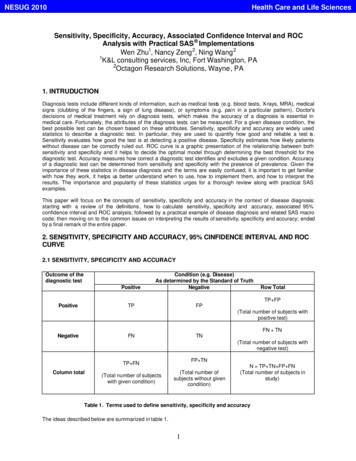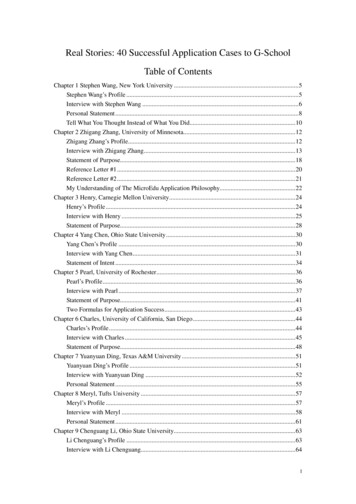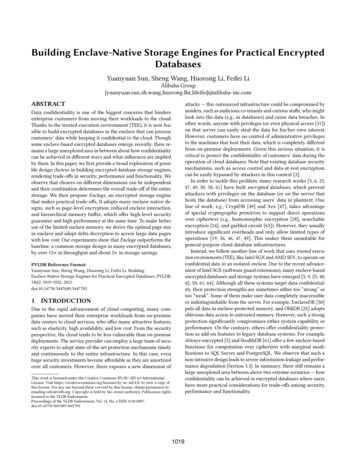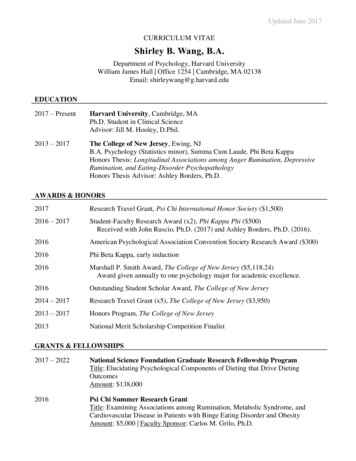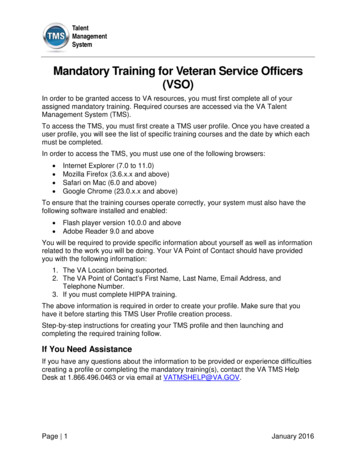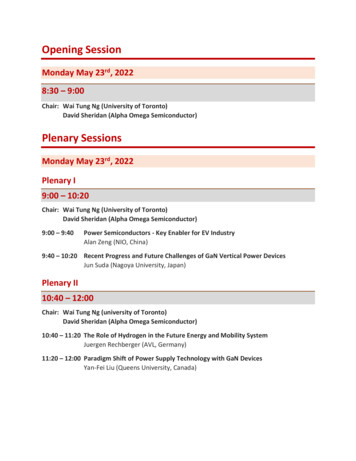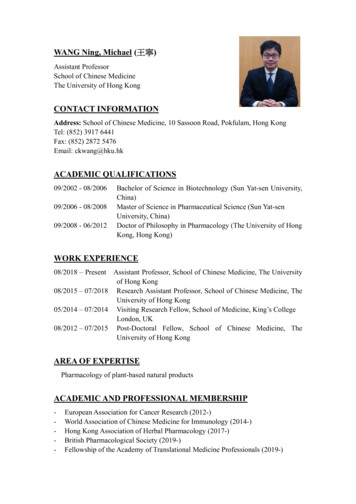
Transcription
WANG Ning, Michael (王寧)Assistant ProfessorSchool of Chinese MedicineThe University of Hong KongCONTACT INFORMATIONAddress: School of Chinese Medicine, 10 Sassoon Road, Pokfulam, Hong KongTel: (852) 3917 6441Fax: (852) 2872 5476Email: ckwang@hku.hkACADEMIC QUALIFICATIONS09/2002 - 08/200609/2006 - 08/200809/2008 - 06/2012Bachelor of Science in Biotechnology (Sun Yat-sen University,China)Master of Science in Pharmaceutical Science (Sun Yat-senUniversity, China)Doctor of Philosophy in Pharmacology (The University of HongKong, Hong Kong)WORK EXPERIENCE08/2018 – PresentAssistant Professor, School of Chinese Medicine, The Universityof Hong Kong08/2015 – 07/2018 Research Assistant Professor, School of Chinese Medicine, TheUniversity of Hong Kong05/2014 – 07/2014 Visiting Research Fellow, School of Medicine, King’s CollegeLondon, UK08/2012 – 07/2015 Post-Doctoral Fellow, School of Chinese Medicine, TheUniversity of Hong KongAREA OF EXPERTISEPharmacology of plant-based natural productsACADEMIC AND PROFESSIONAL MEMBERSHIP-European Association for Cancer Research (2012-)World Association of Chinese Medicine for Immunology (2014-)Hong Kong Association of Herbal Pharmacology (2017-)British Pharmacological Society (2019-)Fellowship of the Academy of Translational Medicine Professionals (2019-)
CURRENT FEATURES OF WORKTeaching subjects: - Pharmacology of Chinese herbal medicine for Bachelor ofChinese Medicine and Bachelor of Pharmacy students- Field Trip & Chinese Medicine Dispensary Practicum- Chinese Materia Medica- Research Progress of Pharmacology and Toxicology of Chineseherbal MedicinesResearch fields: - Discovery of novel natural autophagy regulatory molecules frommedicinal plants- Discovery of natural anti-cancer drug lead from medicinal plants- Discovery of natural compounds from medicinal plants for thetreatment of metabolic disordersPUBLICATIONS(in chronological order, Citation record from Google Scholar)A. Peer-reviewed Journal Articles (*corresponding author)First/co-first or corresponding authorship1. Lu Y, Chan YT, Tan HY, Li S, Wang N*, Feng Y*. Epigenetic regulation inhuman cancer: the potential role of epi-drug in cancer therapy. Mol Cancer.Accepted for publication. (IF: 10.679).2. Tan HY, Wang N (co-first author), Chan YT, Zhang C, Guo W, Chen F, Zhong Z,Li S, Feng Y*. ID1 overexpression increases gefitinib sensitivity in non-smallcell lung cancer by activating RIP3/MLKL-dependent necroptosis. Cancer Lett.2020; 475:109-118. (IF:6.508)3. Wang N, Tan HY, Li S, Wang D, Xu Y, Zhang C, Xia W, Che CM, Feng Y*.Remission of Obesity-Induced Insulin Resistance via Modulating SBP2Expression in Adipose Tissue Macrophages. Sci Adv, 2019, 5, eaav0198.(IF:12.804)4. Wang N, Zhang C, Xu Y, Li S, Tan HY, Xia W, Feng Y*. OMICsapproaches-assisted identification of macrophages-derived MIP-1γ as thetherapeutic target of botanical products TNTL in diabetic retinopathy. CellCommun Signal. 2019; 17(1):81. (IF:5.111)5. Qu Y, Dou B, Tan H, Feng Y*, Wang N*, Wang D*. Tumormicroenvironment-driven non-cell-autonomous resistance to antineoplastictreatment. Mol Cancer. 2019;18(1):69. (IF:10.697)6. Jiang X, Tan HY, Teng S, Chan YT, Wang D*, Wang N*. The Role ofAMP-Activated Protein Kinase as a Potential Target of Treatment ofHepatocellular Carcinoma. Cancers (Basel). 2019;11(5). pii: E647. (IF:6.162)7. Wang N, Tan HY, Feng YG, Zhang C, Chen F, Feng Y*. microRNA-23a inHuman Cancer: Its Roles, Mechanisms and Therapeutic Relevance. Cancers(Basel). 2018;11(1). pii: E7. (IF:6.162)
8.9.10.11.12.13.14.15.16.17.18.19.20.Wang N, Tan HY, Li S, Feng Y*. Atg9b Deficiency Suppresses Autophagy andPotentiates Endoplasmic Reticulum Stress-Associated Hepatocyte Apoptosis inHepatocarcinogenesis. Theranostics, 2017; 7:2325-38. (IF:8.063)Wang N, Tan HY, Li S, Xu Y, Guo W, Feng Y*. Supplementation of MicronutrientSelenium in Metabolic Diseases: Its Role as an Antioxidant. Oxid Med Cell Longev.2017;2017:7478523. (IF:4.868)Lan J, Wang N (co-first author), Huang L, Liu Y, Ma X, Lou H, Chen C, FengY*, Pan W*. Design and synthesis of novel tetrandrine derivatives as potentialanti-tumor agents against human hepatocellular carcinoma. Eur J Med Chem.2017;127:554-66. (IF:4.833)Wang N, Tan HY, Chan YT, Guo W, Li S, Feng Y*. Identification of WT1 asdeterminant of heptatocellular carcinoma and its inhibition by Chinese herbalmedicine Salvia chinensis Benth and its active ingredient protocatechualdehyde.Oncotarget. 2017;8(62):105848-59.Wang N, Wang X, Tan HY, Li S, Tsang CM, Tsao SW, Feng Y*. BerberineSuppresses Cyclin D1 Expression through Proteasomal Degradation in HumanHepatoma Cells. Int J Mol Sci. 2016;17. pii: E1899. (IF:4.183)Wang N, Xu Q, Tan HY, Hong M, Li S, Yuen MF, Feng Y. Berberine Inhibitionof Fibrogenesis in a Rat Model of Liver Fibrosis and in Hepatic Stellate Cells.Evid Based Complement Alternat Med. 2016;2016:8762345. (IF:1.984)Tan HY, Wang N (co-first author), Man K, Tsao SW, Che CM, Feng Y*.Autophagy-induced RelB/p52 activation mediates tumour-associated macrophagerepolarisation and suppression of hepatocellular carcinoma by natural compoundbaicalin. Cell Death Dis. 2015;6:e1942. (IF:5.959)Wang N, Tan HY, Li L, Yuen MF, Feng Y*. Berberine and Coptidis Rhizoma aspotential anticancer agents: Recent updates and future perspectives. JEthnopharmacol. 2015;176:35-48. (IF:3.414)Wang N, Feng Y*, Tan HY, Cheung F, Hong M, Lao L, Nagamatsu T. Inhibitionof eukaryotic elongation factor-2 confers to tumor suppression by a herbalformulation Huanglian-Jiedu decoction in human hepatocellular carcinoma. JEthnopharmacol. 2015;164:309-18. (IF:3.414)Wang N, Feng Y, Cheung F, Wang X, Zhang Z, Feng Y. A Chinese medicineformula Gegen Qinlian decoction suppresses expansion of human renalcarcinoma with inhibition of matrix metalloproteinase-2. Integr Cancer Ther.2015;14:75-85. (IF:2.634)Wang N, Feng Y. Elaborating the role of natural products-induced autophagy incancer treatment: achievements and artifacts in the state of the art. Biomed ResInt. 2015;2015:934207. (IF:2.197)Wang N, Zhu M, Wang X, Tan HY, Tsao SW, Feng Y*. Berberine-induced tumorsuppressor p53 up-regulation gets involved in the regulatory network of MIR-23ain hepatocellular carcinoma. Biochim Biophys Acta. 2014;1839:849-57.(IF:4.599)Xu B, Wang N (co-first author), Pan W, Qiu J, Cao P, Zhu M, Feng Y*, LiangG*. Synthesis and anti-tumor activity evaluation of Matijin-Su derivatives.
Bioorg Chem. 2014;56:34-40. (IF:3.926)21. Wang N, Zhu M, Tsao SW, Man K, Zhang Z, Feng Y*. MiR-23a-mediatedinhibition of topoisomerase 1 expression potentiates cell response to etoposide inhuman hepatocellular carcinoma. Mol Cancer. 2013;12:119. (IF:10.679)22. Wang N, Feng Y*, Zhu M, Siu FM, Ng KM, Che CM. A novel mechanism ofXIAP degradation induced by timosaponin AIII in hepatocellular carcinoma.Biochim Biophys Acta. 2013;1833:2890-9. (IF:4.739)23. Wang N, Zhu M, Tsao SW, Man K, Zhang Z, Feng Y. Up-regulation of TIMP-1by genipin inhibits MMP-2 activities and suppresses the metastatic potential ofhuman hepatocellular carcinoma. PLoS One. 2012;7:e46318. (IF:2.771)24. Wang N, Feng Y, Cheung F, Chow OY, Wang X, Su W, Tong Y. A comparativestudy on the hepatoprotective action of bear bile and Coptidis Rhizoma aqueousextract on experimental liver fibrosis in rats. BMC Complement Altern Med.2012;12:239. (IF:2.479)25. Wang N, Pan W, Zhu M, Zhang M, Hao X, Liang G*, Feng Y*. Fangchinolineinduces autophagic cell death via p53/sestrin2/AMPK signalling in humanhepatocellular carcinoma cells. Br J Pharmacol. 2011;164:731-42. (IF:6.583)26. Wang N, Feng Y, Xie TN, Su W, Zhu M, Chow O, Zhang Y, Ng KM, Leung CH,Tong Y. Chemical and biological analysis of active free and conjugated bile acidsin animal bile using HPLC-ELSD and MTT methods. Exp Ther Med. 2011;2:125-30. (IF:1.448)27. Wang N, Feng Y*, Zhu M, Tsang CM, Man K, Tong Y, Tsao SW. Berberineinduces autophagic cell death and mitochondrial apoptosis in liver cancer cells:the cellular mechanism. J Cell Biochem. 2010;111:1426-36. (IF:3.448)28. Wang N, Feng Y, Lau EP, Tsang C, Ching Y, Man K, Tong Y, Nagamatsu T, Su W,Tsao S. F-actin reorganization and inactivation of rho signaling pathway involvedin the inhibitory effect of Coptidis Rhizoma on hepatoma cell migration. IntegrCancer Ther. 2010; 9:354-64. (IF:2.634)29. Wang N, Li P, Wang Y, Peng W, Wu Z, Tan S, Liang S, Shen X, Su W*.Hepatoprotective effect of Hypericum japonicum extract and its fractions. JEthnopharmacol. 2008;116:1-6. (IF:3.414)Co-authorship30. Huang J, Chen F, Zhong Z, Tan HY, Wang N, Liu Y, Fang X, Yang T, Feng Y.Interpreting the Pharmacological Mechanisms of Huachansu Capsules onHepatocellular Carcinoma Through Combining Network Pharmacology andExperimental Evaluation. Front Pharmacol. 2020 Apr 3;11:414. (IF:3.845)31. Chan YT, Cheung F, Zhang C, Fu B, Tan HY, Norimoto H, Wang N, Feng Y.Ancient Chinese Medicine Herbal Formula Huanglian Jiedu Decoction as aNeoadjuvant Treatment of Chemotherapy by Improving Diarrhea and TumorResponse. Front Pharmacol. 2020 Mar 10;11:252. (IF:3.845)32. Zhang D, Li S, Wang N, Tan HY, Zhang Z, Feng Y. The Cross-Talk Between GutMicrobiota and Lungs in Common Lung Diseases. Front Microbiol. 2020 Feb25;11:301. (IF:4.259)33. Xu Y, Wang N, Tan HY, Li S, Zhang C, Feng Y. Function of Akkermansia
34.35.36.37.38.39.40.41.42.43.44.45.muciniphila in Obesity: Interactions With Lipid Metabolism, Immune Responseand Gut Systems. Front Microbiol. 2020 Feb 21;11:219. (IF:4.259)Zhang C, Wang N, Tan HY, Guo W, Chen F, Zhong Z, Man K, Tsao SW, Lao L,Feng Y. Direct inhibition of TLR4/MyD88 pathway by geniposide suppressesHIF1α-independent VEGF expression and hepatocellular carcinoma angiogenesis.Br J Pharmacol. 2020 Mar 6. (IF:6.583)Guo W, Tan HY, Chen F, Wang N, Feng Y*. Targeting Cancer Metabolism toResensitize Chemotherapy: Potential Development of Cancer Chemosensitizersfrom Traditional Chinese Medicines. Cancers (Basel). 2020;12(2). pii: E404.(IF:6.612)Huang J, Guo W, Cheung F, Tan HY, Wang N, Feng Y*. Integrating NetworkPharmacology and Experimental Models to Investigate the Efficacy of Coptidisand Scutellaria Containing Huanglian Jiedu Decoction on HepatocellularCarcinoma. Am J Chin Med. 2020;48(1):161-182. (IF:3.510)Guo W, Huang J, Wang N, Tan HY, Cheung F, Chen F, Feng Y*. IntegratingNetwork Pharmacology and Pharmacological Evaluation for Deciphering theAction Mechanism of Herbal Formula Zuojin Pill in Suppressing HepatocellularCarcinoma. Front Pharmacol. 2019;10:1185. (IF:3.845)Tan HY, Ho VW, Chan YT, Zhang C, Wang N, Xia W, Feng Y*. Combination ofGentiana rhodantha and Gerbera anandria in the BL02 formula as therapeutics tonon-small cell lung carcinoma acting via Rap1/cdc42 signaling: Atranscriptomics/ bio-informatics biological validation approach. Pharmacol Res.2019;155:104415. (IF:5.574)Li S, Tan HY, Wang N, Feng Y, Wang X, Feng Y*. Recent Insights Into the Roleof Immune Cells in Alcoholic Liver Disease. Front Immunol. 2019 Jun12;10:1328. (IF:4.716)Hong M, Shi H, Wang N, Tan HY, Wang Q, Feng Y*. Dual Effects of ChineseHerbal Medicines on Angiogenesis in Cancer and Ischemic Stroke Treatments:Role of HIF-1 Network. Front Pharmacol. 2019 Jun 26;10:696. (IF:3.845)Fu B, Wang N, Tan HY, Li S, Cheung F, Feng Y*. Multi-Component HerbalProducts in the Prevention and Treatment of Chemotherapy-Associated Toxicityand Side Effects: A Review on Experimental and Clinical Evidences. FrontPharmacol. 2018 Nov 29;9:1394. (IF:3.845)Chen F, Wang N, Tan HY, Guo W, Zhang C, Feng Y*. The functional roles ofexosomes-derived long non-coding RNA in human cancer. Cancer Biol Ther.2019;20(5):583-592. (IF:2.879)Tan HY, Wang N, Lam W, Guo W, Feng Y*, Cheng YC*. Targeting tumourmicroenvironment by tyrosine kinase inhibitor. Mol Cancer. 2018;17(1):43.(IF:10.679)Li S, Tan HY, Wang N, Cheung F, Hong M, Feng Y*. The Potential and ActionMechanism of Polyphenols in the Treatment of Liver Diseases. Oxid Med CellLongev. 2018; 4:8394818. (IF:4.868)Liu Y, Yang A, Qu Y, Wang Z, Zhang Y, Liu Y, Wang N, Teng L, Wang D*.Ameliorative effects of Antrodia cinnamomea polysaccharides against
amide-induced immunosuppression related to Nrf2/HO-1 signaling inBALB/c mice. Int J Biol Macromol. 2018 Sep;116:8-15. (IF:4.784)Li S, Wang N, Tan HY, Hong M, Yuen MF, Li H, Feng Y*. Expansion ofGranulocytic- Myeloid-derived Suppressor Cells in Response to Ethanol-InducedAcute Liver Damage. Front Immunol. 2018;9:1524. (IF: 4.716).Zhang C, Wang N, Xu Y, Li S, Tan HY, Feng Y*. Molecular Mechanisms involvedin Oxidative Stress-Associated Liver Injury induced by Chinese Herbal Medicine:A Literature Review and Network Pharmacology Study. Int J Mol Sci. 2018 Sep13;19(9). (IF: 4.183)Guo W, Tan HY, Wang N, Wang X, Feng Y*. Deciphering hepatocellularcarcinoma through metabolomics: from biomarker discovery to therapy evaluation.Cancer Manag Res. 2018;11;10:715-734. (IF:2.243)Xu Y, Tan HY, Li S, Wang N, Feng Y*. Panax notoginseng forInflammation-Related Chronic Diseases: A Review on the Modulations of MultiplePathways. Am J Chin Med. 2018; 5:1-26. (IF:3.510)Cheng CS, Chen J, Tan HY, Wang N, Chen Z, Feng Y*. Scutellaria baicalensis andCancer Treatment: Recent Progress and Perspectives in Biomedical and ClinicalStudies. Am J Chin Med. 2018;46(1):25-54. (IF:3.510)Zhang C, Xu Y, Tan HY, Li S, Wang N, Zhang Y, Feng Y*. Neuroprotective effectof He-Ying-Qing-Re formula on retinal ganglion cell in diabetic retinopathy. JEthnopharmacol. 2018;214:179-189. (IF:3.414)Li S, Wang N, Hong M, Tan HY, Pan G, Feng Y*. Hepatoprotective Effects of aFunctional Formula of Three Chinese Medicinal Herbs: Experimental Evidenceand Network Pharmacology-Based Identification of Mechanism of Action andPotential Bioactive Components. Molecules. 2018;23(2). pii: E352. (IF:3.060)Zhang C, Wang N, Tan HY, Guo W, Li S, Feng Y*. Targeting VEGF/VEGFRsPathway in the Antiangiogenic Treatment of Human Cancers by TraditionalChinese Medicine. Integr Cancer Ther. 2018;1:1534735418775828. (IF:2.634)Tan HY, Wang N, Li S, Hong M, Guo W, Man K, Cheng CS, Chen Z, Feng Y*.Repression of WT1-Mediated LEF1 Transcription by Mangiferin Governsβ-Catenin-Independent Wnt Signalling Inactivation in Hepatocellular Carcinoma.Cell Physiol Biochem. 2018; 28;47(5):1819-1834.Hong M, Li S, Wang N, Tan HY, Cheung F, Feng Y*. A Biomedical Investigationof the Hepatoprotective Effect of Radix salviae miltiorrhizae and NetworkPharmacology-Based Prediction of the Active Compounds and Molecular Targets.Int J Mol Sci. 2017;18. pii: E620. (IF:4.183)Hong M, Zhang Y, Li S, Tan HY, Wang N, Mu S, Hao X, Feng Y*. A NetworkPharmacology-Based Study on the Hepatoprotective Effect of Fructus Schisandrae.Molecules. 2017;22(10). pii: E1617. (IF:3.060)Hong M, Li S, Tan HY, Cheung F, Wang N, Huang J, Feng Y*. A Network-BasedPharmacology Study of the Herb-Induced Liver Injury Potential of TraditionalHepatoprotective Chinese Herbal Medicines. Molecules. 2017;22. pii: E632.(IF:3.060)Zhou Y, Guo Z, Meng Q, Lu J, Wang N, Liu H, Liang Q, Quan Y, Wang D*, Xie
59.60.61.62.63.64.65.66.67.68.69.70.J*. Cordycepin Affects Multiple Apoptotic Pathways to Mediate HepatocellularCarcinoma Cell Death. Anticancer Agents Med Chem. 2017;17:143-9. (IF:2.180)Huang J, Li L, Cheung F, Wang N, Li Y, Fan Z, Yin F, Yang J, Gao R, He Y, FengY*. Network Pharmacology-Based Approach to Investigate the Analgesic Efficacyand Molecular Targets of Xuangui Dropping Pill for Treating PrimaryDysmenorrhea. Evid Based Complement Alternat Med. 2017;2017:7525179.(IF:1.984)Huang J, Cheung F, Tan HY, Hong M, Wang N, Yang J, Feng Y*, Zheng Q*.Identification of the active compounds and significant pathways of yinchenhaodecoction based on network pharmacology. Mol Med Rep. 2017;16(4):4583-4592.(IF:1.851)Tan HY, Wang N, Li S, Hong M, Wang X, Feng Y*. The Reactive OxygenSpecies in Macrophage Polarization: Reflecting Its Dual Role in Progression andTreatment of Human Diseases. Oxid Med Cell Longev. 2016;2016:2795090.(IF:4.868)Li S, Hong M, Tan HY, Wang N, Feng Y*. Insights into the Role andInterdependence of Oxidative Stress and Inflammation in Liver Diseases. OxidMed Cell Longev. 2016;2016:4234061. (IF:4.868)Wang J, Song J, Wang D, Zhang N, Lu J, Meng Q, Zhou Y, Wang N, Liu Y,Wang D*, Teng L*. The anti-membranous glomerulonephritic activity of purifiedpolysaccharides from Irpex lacteus Fr. Int J Biol Macromol. 2016;84:87-93.(IF:4.784)Tan HY, Wang N, Takahashi M, Feng Y, Li H, Feng Y*. New Natural PigmentFraction Isolated from Saw Palmetto: Potential for Adjuvant Therapy ofHepatocellular Carcinoma. Int J Mol Sci. 2016;17. pii: E1277. (IF:4.183)Hong M, Tan HY, Li S, Cheung F, Wang N, Nagamatsu T, Feng Y*. Cancer StemCells: The Potential Targets of Chinese Medicines and Their Active Compounds.Int J Mol Sci. 2016;17. pii: E893. (IF:4.183)Lam P, Cheung F, Tan HY, Wang N, Yuen MF, Feng Y*. HepatoprotectiveEffects of Chinese Medicinal Herbs: A Focus on Anti-Inflammatory andAnti-Oxidative Activities. Int J Mol Sci. 2016;17(4):465. (IF:4.183)Liu T, Wang N, Zhang L*, Zhong L*. Chinese Herbal Medicine for FunctionalAbdominal Pain Syndrome: From Clinical Findings to Basic Understandings.Evid Based Complement Alternat Med. 2016;2016:8652523. (IF:1.984)Li S, Tan HY, Wang N, Hong M, Li L, Cheung F, Feng Y*. Substitutes for BearBile for the Treatment of Liver Diseases: Research Progress and FuturePerspective. Evid Based Complement Alternat Med. 2016;2016:4305074.(IF:1.984)Tan HY, San-Marina S, Wang N, Hong M, Li S, Li L, Cheung F, Wen XY, FengY*. Preclinical Models for Investigation of Herbal Medicines in Liver Diseases:Update and Perspective. Evid Based Complement Alternat Med.2016;2016:4750163. (IF:1.984)Tan HY, Wang N, Tsao SW, Che CM, Yuen MF, Feng Y*. IRE1α inhibition bynatural compound genipin on tumour associated macrophages reduces growth of
hepatocellular carcinoma. Oncotarget. 2016;7:43792-804.71. Hong M, Wang N, Tan HY, Tsao SW, Feng Y*. MicroRNAs and ChineseMedicinal Herbs: New Possibilities in Cancer Therapy. Cancers (Basel).2015;7:1643-57. (IF:6.162)72. Hong M, Li S, Tan HY, Wang N, Tsao SW, Feng Y*. Current Status of HerbalMedicines in Chronic Liver Disease Therapy: The Biological Effects, MolecularTargets and Future Prospects. Int J Mol Sci. 2015;16:28705-45. (IF:4.183)73. Li S, Tan HY, Wang N, Zhang ZJ, Lao L, Wong CW, Feng Y*. The Role ofOxidative Stress and Antioxidants in Liver Diseases. Int J Mol Sci.2015;16:26087-124. (IF:4.183)74. Wang L, Wang N, Tan HY, Zhang Y, Feng Y*. Protective effect of a ChineseMedicine formula He-Ying-Qing-Re Formula on diabetic retinopathy. JEthnopharmacol. 2015;169:295-304. (IF:3.414)75. Wang X, Wang N, Cheung F, Lao L, Li C, Feng Y*. Chinese medicines forprevention and treatment of human hepatocellular carcinoma: current progress onpharmacological actions and mechanisms. J Integr Med. 2015;13:142-64.76. Tan HY, Wang N, Tsao SW, Zhang Z, Feng Y*. Suppression of vascularendothelial growth factor via inactivation of eukaryotic elongation factor 2 byalkaloids in Coptidis rhizome in hepatocellular carcinoma. Integr Cancer Ther.2014;13:425-34. (IF:2.634)77. Wang X, Feng Y*, Wang N, Cheung F, Tan HY, Zhong S, Li C, Kobayashi S.Chinese medicines induce cell death: the molecular and cellular mechanisms forcancer therapy. Biomed Res Int. 2014;2014:530342. (IF:2.197)78. Tian Y, Teng LR, Song JJ, Meng QF, Lu JH, Zhang WW, Wei K, Wang N, WangD*, Teng LS*. Studies on the analgesic activities of Jia-Yuan-Qing pill and itssafety evaluation in mice. Protoplasma. 2014; 251:1245-53. (IF:2.633)79. Cheung F, Wang X, Wang N, Yuen MF, Ziea TC, Tong Y, Wong VT, Feng Y*.Chinese Medicines as an Adjuvant Therapy for Unresectable HepatocellularCarcinoma during Transarterial Chemoembolization: A Meta-Analysis ofRandomized Controlled Trials. Evid Based Complement Alternat Med.2013;2013:487919. (IF:2.064)80. Cheung F, Feng Y*, Wang N, Yuen MF, Tong Y, Wong VT. Effectiveness ofChinese herbal medicine in treating liver fibrosis: a systematic review andmeta-analysis of randomized controlled trials. Chin Med. 2012;7:5. (IF:2.265)81. Wang XB, Feng Y*, Wang N, Cheung F, Wong CW. Recent progress onanti-liver fibrosis candidates in patents of herbal medicinal products. Recent PatFood Nutr Agric.2012;4:91-106.82. Feng Y*, Wang N, Ye X, Li H, Feng Y, Cheung F, Nagamatsu T.Hepatoprotective effect and its possible mechanism of Coptidis rhizoma aqueousextract on carbon tetrachloride-induced chronic liver hepatotoxicity in rats. JEthnopharmacol. 2011;138:683-90. (IF:3.414)83. Zhu M, Wang N, Tsao SW, Yuen MF, Feng Y, Wan TS, Man K, Feng Y*.Up-regulation of microRNAs, miR21 and miR23a in human liver cancer cellstreated with Coptidis rhizoma aqueous extract. Exp Ther Med. 2011; 2:27-32.
(IF:1.448)84. Feng Y*, Wang N, Zhu M, Feng Y, Li H, Tsao S. Recent progress on anticancercandidates in patents of herbal medicinal products. Recent Pat Food Nutr Agric.2011; 3:30-48.85. Feng Y*, Siu KY, Ye X, Wang N, Yuen MF, Leung CH, Tong Y, Kobayashi S.Hepatoprotective effects of berberine on carbon tetrachloride-induced acutehepatotoxicity in rats. Chin Med. 2010;5:33. (IF:2.265)86. Tang J, Feng Y*, Tsao S, Wang N, Curtain R, Wang Y. Berberine and Coptidisrhizoma as novel antineoplastic agents: a review of traditional use and biomedicalinvestigations. J Ethnopharmacol. 2009;126:5-17. (IF:3.414)87. Feng Y*, Siu K, Wang N, Ng KM, Tsao SW, Nagamatsu T, Tong Y. Bear bile:dilemma of traditional medicinal use and animal protection. J EthnobiolEthnomed. 2009; 5:2. (IF:2.273)88. Feng Y*, Cheung KF, Wang N, Liu P, Nagamatsu T, Tong Y. Chinese medicinesas a resource for liver fibrosis treatment. Chin Med. 2009;4:16. (IF:2.265)89. Guan S, Su W*, Wang N, Li P, Wang Y. Effects of radix polygoni multifloricomponents on tyrosinase activity and melanogenesis. J Enzyme Inhib MedChem. 2008; 23:252-5. (IF:4.027)90. Guan S, Su W*, Wang N, Li P, Wang Y. A potent tyrosinase activator from RadixPolygoni multiflori and its melanogenesis stimulatory effect in B16 melanomacells. Phytother Res. 2008; 22:660-3. (IF:3.766)B. Books and Book chaptersBooks1. Associate Editor in Anticancer Chinese Medicines: Origen, chemistry,pharmacology and clinical application, Editor-in-Chief by Xu HX, Zhu GF, FengY. Science Publisher, Shanghai. 2016, Accepted for publication.2. Editorial Member in Basic and Clinical Toxicology of Chinese Medicines,Editor-in-Chief by Feng Y. Commercial Press (HK) Ltd. 2009, pp394. (inChinese).Chapter in book3. Chen F, Wang N, Feng Y. (2018). What Chinese Medicine can do for livercancer?. In Liver Cancer, Ahmed Lasfar (Ed.), InTech (Accepted)4. Li S, Wang N, Feng YG, Li HY, Feng Y. (2018). Antioxidants In The PreventionAnd Treatment Of Liver Diseases. In Nutritional Antioxidant Therapies:Treatments and Perspectives, Al-Gubory, KH and Laher, I (Eds.), Springer-Verlag.DOI: 10.1007/978-3-319-67625-8 18.5. Guo W, Wang N and Feng Y (2017). Recent Progress on the MolecularMechanisms of Anti-invasive and Metastatic Chinese Medicines for CancerTherapy In Unique Aspects of Anti-cancer Drug Development, Dr. JolantaLatosińska (Ed.), InTech, DOI: 10.5772/intechopen.69017.6. Hong M, Wang N and Feng Y (2016). Liver Cancer Treatment by ChineseMedicines and their Active Compounds, Anti-cancer Drugs - Nature, Synthesisand Cell, Dr. Jasna Bankovic (Ed.), InTech, DOI: 10.5772/65319.
7.Feng Y, Li L, Li S, Wang N (2016). Study Liver Diseases, Chapter in TCM inProfessional English for Traditional Chinese Medical Research (Tang Yao andLao Lixing Editor in Chief). Beijing: People's Medical Publishing House.Accepted for publication. (In English. Textbook for postgraduate students).8. Wang N, Feng Y (2016). Quality Control of Chinese Herbal Medicine, Chapter inProfessional English for Traditional Chinese Medical Research, Editor-in-Chiefby Tong Y and Lao L. Beijing: People's Medical Publishing House. 2016,Accepted for publication. (In English. Textbook for postgraduate students).9. Wang N, Zhong L (2016). Summary of Advance of Chinese Medicine research inHong Kong (2015), Chapter in Yearbook of Traditional Chinese Medicine ofChina. Beijing, China Press of Traditional Chinese Medicine, pp422-34.10. Zhang Y, Hong M, Li L, Wang N, Feng Y (2016). Classification of ChineseHerbal Medicine and its recent researches. Chapter in Traditional and Folk HerbalMedicine: Recent Researches -Vol.3 Editor: V.K. Gupta. Published by DayaPublishing House, A Division of Astral International Pvt. Ltd. New Delhi, India.2016, p229-297.11. Tan H, Wang L, Cheung F, Wang N, Feng Y. (2016) Phytochemistry,Pharmacology and Therapeutics of Coptis: panacea for multiple diseases?Chapter in Medicinal Plants: Phytochemistry, Pharmacology andTherapeutics-Vol.4. Editor in Chief: V.K. Gupta. Published by Daya PublishingHouse, A Division of Astral International Pvt. Ltd. New Delhi, INDIA. 2016,p1-39.12. Hong M, Wang N and Feng Y (2015). The Role of Cell Autophagy in Cancer andIts Application in Drug Discovery, Cell Death - Autophagy, Apoptosis andNecrosis, Dr. Tobias Ntuli (Ed.), InTech, DOI: 10.5772/61780.13. Li L, Wang N, Feng Y. (2015) The Preventive and Therapeutic Effect of CoptidisRhizoma and Berberine in Cancer. In Understand Cancer: Research andTreatment. iConcept Press. iConcept Press.14. Alan Worsley, Feng Y, Wang N, Ho Faith, Yu Edwin, Rose Mak. (2013) Use ofHerbs in Chinese and Western Medicine. Hong Kong Museum of MedicalSciences Society. 1th edition in Bilingual in Chinese and English, Hong Kong,China. pp67.15. Feng YG, Wang N, Chueng F, Zhu M, Li H, Feng Y. Molecular and CellularMechanism Studies on Anticancer Effects of Chinese Medicines. (2011 Chapterin Biomedical Engineering, Trends, Research and Technologies / Book 3. pp644.16. Feng Y, Chen XM, Wang N and Shen JG. (2010) Current Progress on MedicinalPlants and their Biological Properties in Contemporary China. Chapter in RecentProgress in Medicinal Plants Vol. 28: Ethnomedicine: Source & Mechanism-II.Studium Press LLC, USA, pp491-546.Gene Atlas17. Feng Y, Tan HY, Wang N, Zhu M, Cheung F, Hong M. (2013) microRNA23a inAtlas of Genetics and Cytogenetics in Oncology and Haematology.C. Conference Papers or Abstracts in Proceedings or Journals (reverse
chronological order):Overseas1. Wang N, Feng Y. The role of Autophagy protein 9b in liver carcinogenesis. The25th Biennial Congress of the European Association for Cancer Research,Amsterdam, Netherland, June 30-July 3, 2018.2. Tan HY, Wang N, Feng Y. Genetical inhibition of IRE1α in macrophagessuppresses hepatocellular carcinoma growth. The 25th Biennial Congress of theEuropean Association for Cancer Research, Amsterdam, Netherland, June 30-July3, 2018.3. Li S, Wang N, Feng Y. The Protective Role of Myeloid-derived Suppressor Cellsin Acute Alcoholic Liver Injury. Poster presentation in Gordon ResearchConferences: Alcohol-Induced End Organ Diseases, Ventura, CA, USA, March26-31, 2017.4. Feng Y, Wang N. Drug Discovery from Chinese Medicines: What’s New in Next?6th International Conference and Exhibition on Traditional & AlternativeMedicine” (Traditional Medicine-2016), Amsterdam, Netherlands, September14-16, 2016.5. Wang N, Feng Y. Exploring coptis and berberine as novel treatment forhepatocellular carcinoma targeting microRNAs. 15th Meeting of Consortium forGlobalization of Chinese Medicine (CGCM), Academia Sinica, Taipei, August 23- 25, 2016.6. Li S, Wang N, Feng Y. Anti-oxidative and anti-inflammatory effects of Chinesemedicines in alcoholic liver models. 15th Meeting of Consortium forGlobalization of Chinese Medicine (CGCM), Academia Sinica, Taipei, August 23- 25, 2016.7. Tan HY, Wang N, Feng Y. Baicalin as a therapeutic candidate of macrophagereprogramming-mediated HCC tumor inhibition. 15th Meeting of Consortium forGlobalization of Chinese Medicine (CGCM), Academia Sinica, Taipei, August 23- 25, 2016.8. Li L, Cheung F, Wang N, Feng Y. An Experiential Teaching and LearningModule in Chinese Medicine: Field Trip. 15th Meeting of Consortium forGlobalization of Chinese Medicine (CGCM), Academia Sinica, Taipei, August 23- 25, 2016.9. Hong M, Wang N, Feng Y. A Biomedical Investigation on the HepatoprotectiveEffect of Coriolus versicolor L and Salvia miltiorrhiza Bge. The InternationalConference and Exhibition on Marine Drugs and Natural Products, Melbourne,Australia, July 25-27, 2016.10. Wang N, Feng Y. MicroRNAs mediate regulation of chemoresistance ofhepatocellular carcinoma cells with involvement of p53 tumour suppressor. 24thBiennial Congress of the European Association for Cancer Research (EACR24),Manchester, UK. July 9-12, 2016.11. Tan HY, Wang N, Feng Y. Autophagy mediated activation of RelB/p52responsible for the reprogramming of tumour associated macrophages. 24thBiennial Congress of the European Association for Cancer Research (EACR24),
Manchester, UK. July 9-12, 2016.12. Feng Y, Wang N. Anticancer effect of coptis: Destination of its two thousandyears journey? 2th international conference and exhibition on pharmacology andEthnopharmacology, Chicago, USA, May 1-4, 2016.13. Feng Y, Wang N. Drug Discovery from Chinese Medicines: Opportunity andChallenge. 7th International Conference on Drug Discovery and Therapy (7thICDDT), Sharjah, UAE, February 15th-18th, 2016.14. Feng Y, Wang N, Yuen MF. Breaking liver disease chain by Chinese medicines:evidences for preventing and treating hepatocellular carcinoma. Abstract Book201, 14th Meeting of the Consortium for Globalization of Chinese Medicine(CGCM). London On, Canada. August 18-20, 2015.15. Wang N, Tan HY, Feng Y. Suppression of nascent protein synthesis by naturalproduct berberine. 19th World Congress on Advances in Oncology & 17thInternational symposium on Molecular Medicine, Athens, Greece, October 9-11,2014.16. Tan H, Wang N, Feng Y. Hepatoprotective effect of Coptidis rhizoma aqueousextract on liver fibrosis rat models. Abstract Book p217. 12th Meeting of theConsortium for Globalization of Chinese Medicine (CGCM). Graz, Austria.August 27-29, 2013.17. Wang N, Feng Y.
WANG Ning, Michael (王寧) Assistant Professor School of Chinese Medicine The University of Hong Kong CONTACT INFORMATION Address: School of Chinese Medicine, 10 Sassoon Road, Pokfulam, Hong Kong Tel: (852) 3917 6441 Fax: (852) 2872 5476 Email: ckwang@hku.hk ACADEMIC QUALIFICATIONS
